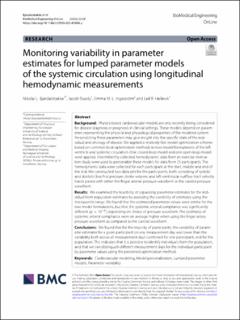| dc.contributor.author | Bjørdalsbakke, Nikolai Lid | |
| dc.contributor.author | Sturdy, Jacob Trent | |
| dc.contributor.author | Ingeström, Emma Maria Lovisa | |
| dc.contributor.author | Hellevik, Leif Rune | |
| dc.date.accessioned | 2023-11-22T09:03:28Z | |
| dc.date.available | 2023-11-22T09:03:28Z | |
| dc.date.created | 2023-05-02T12:22:24Z | |
| dc.date.issued | 2023 | |
| dc.identifier.citation | Biomedical engineering online. 2023, 22 (1), 34-?. | en_US |
| dc.identifier.issn | 1475-925X | |
| dc.identifier.uri | https://hdl.handle.net/11250/3104017 | |
| dc.description.abstract | Background
Physics-based cardiovascular models are only recently being considered for disease diagnosis or prognosis in clinical settings. These models depend on parameters representing the physical and physiological properties of the modeled system. Personalizing these parameters may give insight into the specific state of the individual and etiology of disease. We applied a relatively fast model optimization scheme based on common local optimization methods to two model formulations of the left ventricle and systemic circulation. One closed-loop model and one open-loop model were applied. Intermittently collected hemodynamic data from an exercise motivation study were used to personalize these models for data from 25 participants. The hemodynamic data were collected for each participant at the start, middle and end of the trial. We constructed two data sets for the participants, both consisting of systolic and diastolic brachial pressure, stroke volume, and left-ventricular outflow tract velocity traces paired with either the finger arterial pressure waveform or the carotid pressure waveform.
Results
We examined the feasibility of separating parameter estimates for the individual from population estimates by assessing the variability of estimates using the interquartile range. We found that the estimated parameter values were similar for the two model formulations, but that the systemic arterial compliance was significantly different (
) depending on choice of pressure waveform. The estimates of systemic arterial compliance were on average higher when using the finger artery pressure waveform as compared to the carotid waveform.
Conclusions
We found that for the majority of participants, the variability of parameter estimates for a given participant on any measurement day was lower than the variability both across all measurement days combined for one participant, and for the population. This indicates that it is possible to identify individuals from the population, and that we can distinguish different measurement days for the individual participant by parameter values using the presented optimization method. | en_US |
| dc.language.iso | eng | en_US |
| dc.publisher | BMC | en_US |
| dc.rights | Navngivelse 4.0 Internasjonal | * |
| dc.rights.uri | http://creativecommons.org/licenses/by/4.0/deed.no | * |
| dc.title | Monitoring variability in parameter estimates for lumped parameter models of the systemic circulation using longitudinal hemodynamic measurements | en_US |
| dc.title.alternative | Monitoring variability in parameter estimates for lumped parameter models of the systemic circulation using longitudinal hemodynamic measurements | en_US |
| dc.type | Journal article | en_US |
| dc.type | Peer reviewed | en_US |
| dc.description.version | publishedVersion | en_US |
| dc.source.volume | 22 | en_US |
| dc.source.journal | Biomedical engineering online | en_US |
| dc.source.issue | 1 | en_US |
| dc.identifier.doi | 10.1186/s12938-023-01086-y | |
| dc.identifier.cristin | 2144681 | |
| cristin.ispublished | true | |
| cristin.fulltext | original | |
| cristin.qualitycode | 1 | |

